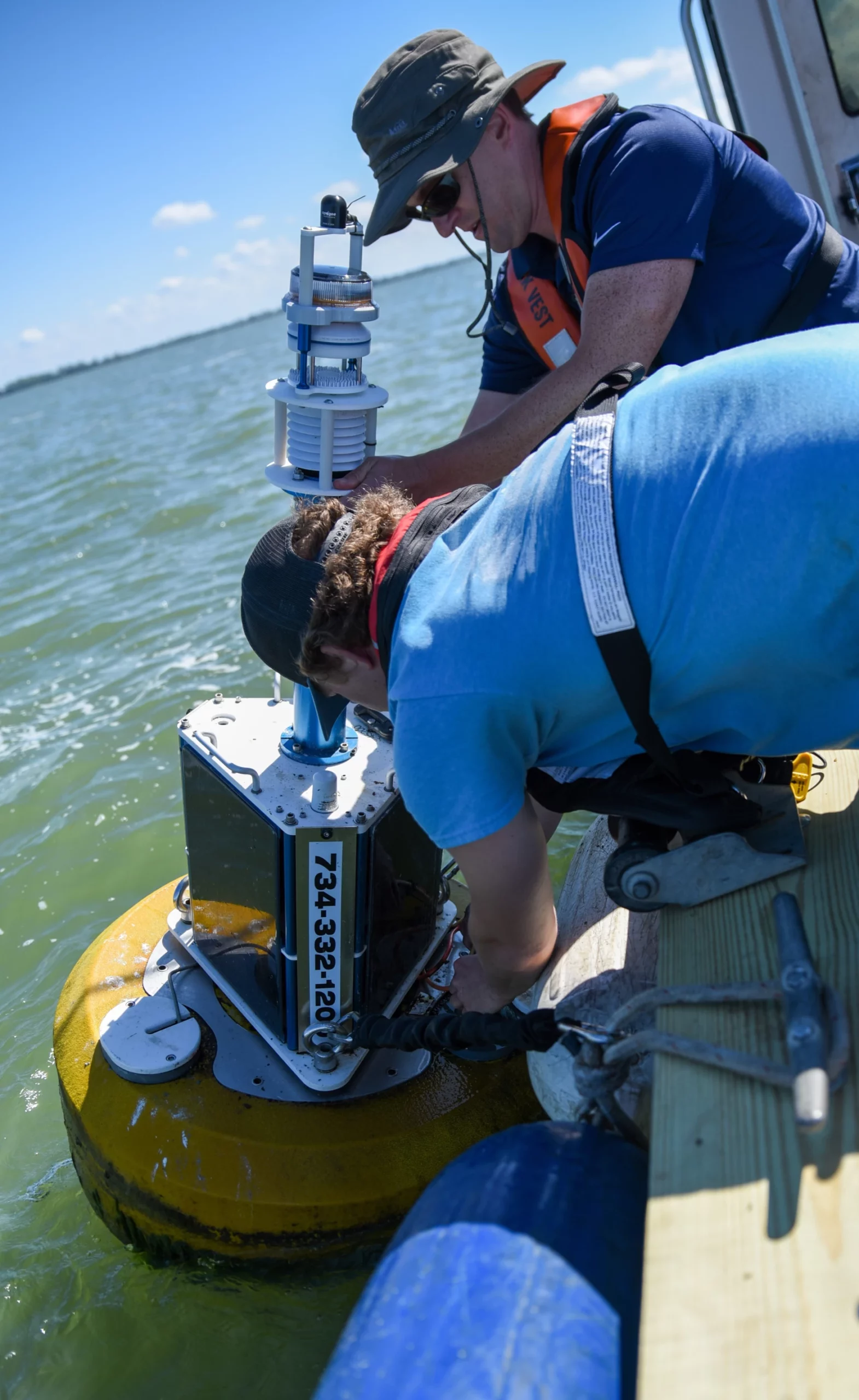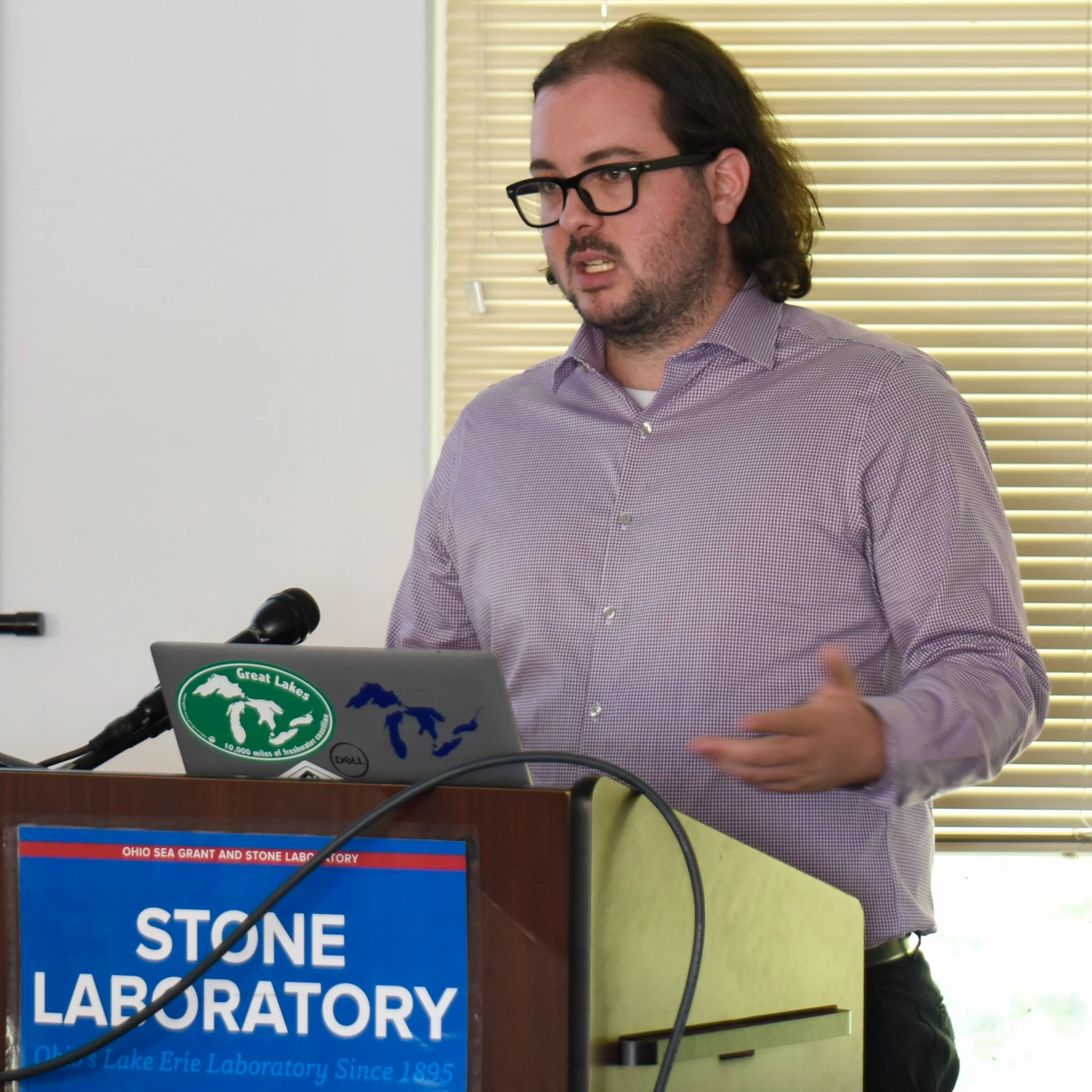
By Lester Graham, Michigan Radio
The Great Lakes News Collaborative includes Bridge Michigan; Circle of Blue; Great Lakes Now at Detroit Public Television; and Michigan Radio, Michigan’s NPR News Leader; who work together to bring audiences news and information about the impact of climate change, pollution, and aging infrastructure on the Great Lakes and drinking water. This independent journalism is supported by the Charles Stewart Mott Foundation. Find all the work HERE.
There are sensors measuring water quality over a large swath of Lake Erie. An effort is underway to connect those sensors on buoys and other equipment in a way that will give more insight into the problems with the lake. And that data might be insightful for the people who can tackle those problems.
Lake Erie is shallow. That means pollution from industry, agriculture, and urban runoff has a greater impact there than it would on the other larger and deeper Great Lakes. And the population density along Lake Erie’s coasts is greater than along the other lakes.
There are also a lot of people who enjoy the lake, boating, swimming, and fishing. It’s got more fish than any one of the other Great Lakes.
Paul Pacholski is the President of the Lake Erie Charter Boat Association. He says he and his colleagues rely on information from buoys in the lake.
“But it’s not just charter boat captains. I know a lot of private boaters that also access the information coming from these buoys,” Pacholski said.
Those buoys are equipped with sensors that pick up information about water conditions. They gather measurements of wave heights, the spread of cyanobacteria, and the clarity of the water. That’s useful information when you’re looking for the right place to fish.
“That saves you a lot of fuel and a lot of worrying around headaches because you pretty much know what you’re going to get yourself into when you go out there,” Pacholski explained.
But you can only get that information if you know the cell phone number of the buoy.
That’s right. The buoys have a cell phone number. And people like Pacholski literally have to text the buoy and get a text back. If a buoy is out of cell range, it’s no good to the boaters.

Ed Verhamme is a Principal and Senior Engineer at LimnoTech and President of Freeboard Technology, a new water tech start-up. (Photo Credit: Lester Graham/Michigan Radio)
“We’ve been having a challenging time getting signal offshore, and that’s mostly cell signal,” said Ed Verhamme, senior engineer with LimnoTech, based in Ann Arbor. It places buoys in the water and and keeps the sensors operating.
When Verhamme says there’s a challenge getting a cell signal, he’s not talking about people getting a signal on their phone. He’s talking about the cell signal used by the buoys.
Since there is no cell service over large areas of Lake Erie, there’s only so far out they can place buoys to convey information about water quality in real time.
The Cleveland Water Alliance is working on an idea to make it possible to put more buoys to work by ditching the cell signals and switching to low-power radio signals networked from buoy to buoy. The data are relayed to a receiver and then distributed on the internet. The state of Ohio is supporting the effort with grants.
“So we’re basically creating this regional Wi-Fi that’s meant for devices. That data will make its way back to the internet via a radio that we’ve installed at a university or on top of a tower,” Verhamme explained.

Zach Gordon and Greg Cutrell of LimnoTech finish up maintenance of scientific gear onboard a Lake Erie buoy. (Photo Credit: Lester Graham/Michigan Radio)
As we talked, two of Verhamme’s colleagues were busy cleaning the sensors carried by a yellow buoy that had been pulled to the side of the boat we were on.
“Everything that you see in front of her here with the buoy was paid for by Cleveland Water Alliance and then we partnered with a couple other stakeholders to add things like the acoustic fish telemetry as well as water quality test equipment in partnership with the University of Toledo,” said Zach Gordon, a mechanical engineer with LimnoTech.
Not having to rely on cell signals will save money and it will make the data a lot easier to access because it’s automatically put online for the use of anyone.
Most of the data collected is for government entities, so it belongs to the public.
This radio signal network is being built all along the Ohio Lake Erie coast.
During an address at the Ohio State University’s Stone Lab, the Program Manager at the Cleveland Water Alliance, Max Herzog, explained they’re building a Smart Lake Erie.
“When we talk about a Smart Lake Erie Watershed, this is very much taking some of the core technologies and philosophies from the smart cities movement.”
Herzog said lots of sensors across a wide area and big data management can apply to a large watershed such as Lake Erie’s.
This long-range, wide-area network is not limited to buoys.
“Sensors can be on bridges. They can be on stationary ships. They can be within creeks and streams and waterways,” said Samantha Martin, communications manager for the alliance.

Cleveland Water Alliance Program Manager Max Herzog, speaking to Lake Erie stakeholders and journalists gathered at Ohio State University’s Stone Lab about building a Smart Lake Erie Watershed. (Photo Credit: Lester Graham/Michigan Radio)
And those kinds of data are valuable to all sorts of people: those charter boat captains and boaters we talked about, as well as municipalities. Drinking water plant operators will be better able to monitor water quality from more places that might eventually affect their water sources.
And scientists won’t be limited to just their own data, but can see other data being gathered by those public entities and other researchers. And it can be used in unique ways not anticipated immediately.
“We’ve had it used in search and rescue operations. You know, if someone capsizes, they’ll be able to look at wind speed and wave height to try to figure out where they might be,” Martin said.
The bottom line is this Smart Lake Erie network will allow anyone access, in real time, to public data from Lake Erie — online.
Martin said the network is also a testbed for new kinds of sensors.
“One thing that we’re working to identify is a technology, a sensor technology, that can detect E. coli in real time,” she said.
Right now, water samples are taken to a lab. That takes time. Meanwhile kids could be swimming in water that could make them sick.
The backers of this network of sensors say as more people become aware of the possibilities, the information that’s gathered will evolve.
They say it’s hard to imagine all the ways it could be used, but they think it could be critical to solving some of the challenges Lake Erie faces.
The network already covers 6,500 square miles of Lake Erie. The Cleveland Water Alliance plans the nearly double that coverage.
There’s little doubt that other Great Lakes states are watching this closely.
Catch more news at Great Lakes Now:
The spawn from lake sturgeon in Michigan to be introduced to Cuyahoga River
Wetland banks save cities, townships, and counties money for building roads
Featured image: LimnoTech Mechanical Engineer Zach Gorder, left, and Project Scientist Greg Cutrell, right, remove obstructions from the surfaces of sensors on a buoy in Lake Erie. (Photo Credit: Lester Graham)




